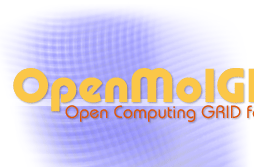|
Home » Frequently Asked Questions (FAQ)
Frequently Asked Questions (FAQ)
Q: What is the Grid?
Q: What does "open" mean in the name OpenMolGRID?
Q: What is UNICORE, a standard? Who is developing it?
Q: What kind of IT background should the company possess who wants to use the system?
Q: What platform does the OpenMolGRID system run on?
Q: Is UNICORE commercially available?
Q: The most important issue for pharma industry is security and trust regarding their proprietary data. How does OpenMolGRID handle these issues?
Q: What is the OpenMolGRID strategy for handling conformation analysis? How many conformers are taken into account during the calculations?
Q: Will the OpenMolGRID system deal with stereochemistry problems? These questions are still unsolved in prediction software.
Q: How can get new items to be wired into the OpenMolGRID system? Building a system that is able to predict toxicity in general is ambitious. There are many software packages in the market but each of them has different a set of capabilities.
Q: What is the Grid?
A: The idea behind the term "Grid Computing" is that in a Grid the access to computing resources, applications, data, and experiments is as easy as the access to electrical power (power grid). Grids are intrinsically distributed and heterogeneous but must be viewed by the user as a virtual environment with uniform access to resources.Further information on Grids can for example be found at http://www.buyya.com/papers/gridtech.pdf
Q: What does "open" mean in the name OpenMolGRID?
A: The system was designed to be open in a sense that it is possible to extend the system by integrating the best open source and proprietary software packages.
Q: What is UNICORE, a standard? Who is developing it?
A: UNICORE (uniform Interface to Computing Resources) is a vertically integrated Grid system offering:
• a graphical user interface for the preparation and monitoring of complex jobs,
• data management,
• resource management,
• application support,
• flow control,
• strong security, and
• single sign-on.
It has been developed in several German and European projects and is available as open source under BSD license from http://unicore.sourceforge.net. Currently it is evolving towards a web service based, service oriented architecture.
Q: What kind of IT background should the company possess who wants to use the system?
A: Depending on the role of a user, the following IT backround is expected:
- A user of the system does not need any specific IT knowledge
besides his/her application, he/she just uses a seamless graphical user
interface.
- An administrator of the server side needs Unix/Linux system
administrator skills and basic Java as well as public key cryptography
knowledge.
- A plugin developer (graphical application interface) needs good
Java development skills and should be familiar with the application.
Q: What platform does the OpenMolGRID system run on?
A: The OpenMolGRID system is based on the UNICORE infrastructure. The UNICORE itself has a client-server architecture. The client can run on any platform where a Java virtual machine (JVM) is available (e.g. Windows, Linux, Mac, etc). The server side components require Unix like operating system with the JVM installed. The security infrastructure needs X509 certificates.
Q: Is UNICORE commercially available?
A: UNICORE is available as open source software under BSD license. Currently, there's no commercial support available. Limited support is available on a best-effort basis from the developer community at http://unicore.sourceforge.net
Q: The most important issue for pharma industry is security and trust regarding their proprietary data. How does OpenMolGRID handle these issues?
A: UNICORE already provides strong, end-to-end security using X509 public key cryptography. In addition, the OpenMolGRID data access architecture supports user-by-user authentication, providing additional access control for the administrators of the database.
Q: What is the OpenMolGRID strategy for handling conformation analysis? How many conformers are taken into account during the calculations?
A: We have not yet integrated software for the conformation analysis, although the data storage is already designed for holding molecules with multiple conformations.
Q: Will the OpenMolGRID system deal with stereochemistry problems? These questions are still unsolved in prediction software.
A: This is a general problem in the QSAR modelling. In the present system we have molecular descriptors that do not depend on the stereochemistry of a molecule. We are working on the issue and are open to collaboration on this field.
Q: How can new items be wired into the OpenMolGRID system? Building a system that is able to predict toxicity in general is ambitious. There are many software packages in the market but each of them has different a set of capabilities.
A: The integration of applications into the OpenMolGRID system is described in detail at Grid Integration. The basic idea behind the integration is that we are leaving the application codes as they are and define standard interfaces to the tasks the application provides. Wrappers are developed to adapt the software packages to the standard interface for the respective task.
|


